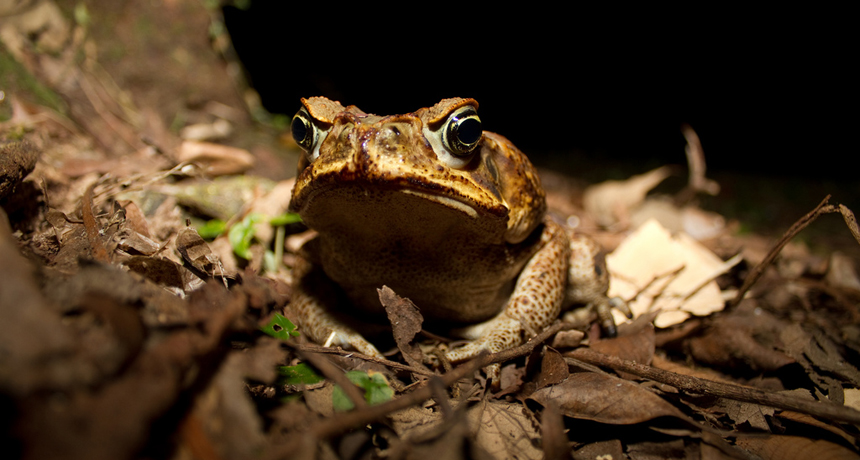Cane toads can handle the cool

Since cane toads were introduced to Australia in the early 20th century for pest control, they’ve spread across the country. And now they’ve been found moving up the mountains.
brian.gratwicke/Flickr
- More than 2 years ago
Australia has a cane toad problem. The amphibians are not native to the continent; they were introduced in the state of Queensland back in 1935 as pest control in the sugar fields. But then the toads got out of control and became pests themselves.
Cane toads (Rhinella marina) protect themselves with poison, and that poison kills any animals that eat the toads. That’s made a big dent in populations of native animals such as snakes, goannas and adorable marsupials called quolls.
Since the toads first arrived in Australia, they’ve been spreading west across the northern reaches of the continent, and they’ve been moving faster year after year. Researchers had thought that there was a limit on how far the toads could spread south and up the sides of mountains, though. Cane toads are natives of central and South America, and there are thermal limits on where they can live. But it seems the toads can handle cooler temperatures than previously thought, which could let them invade places that were considered too cool for toads.
This new research, published January 26 in Functional Ecology, comes out of the lab of Rick Shine at the University of Sydney. Shine, a herpetologist, began studying the toads when they invaded his long-term research site at Fogg Dam near Darwin. Since then, he and his colleagues have learned an incredible amount about cane toad biology and how the toads interact with the ecosystem, and even how the spread of the toads might be halted.
Australian cane toads constantly surprise researchers and the amphibians, Shine and his colleagues note in their paper, have now spread to areas much colder than what is found in their native range in the Americas. In northeastern New South Wales, the toads can be found in mountains living at elevations up to 1,100 meters. What has allowed their move into these cooler climes?
Shine’s group started by collecting toads from high and low elevations. They then determined the lowest temperature that each toad could handle by placing the toad into a container within an insulated box full of ice. Every 10 minutes, the toad would be removed from the box, have its internal temperature measured and then be placed on its back. A researcher would nudge the toad’s abdomen with a small brush, and if the toad couldn’t right itself within 30 seconds, it was considered to have reached its “critical thermal minimum” (CTMin) for body temperature.
Toads from higher elevations had lower CTMins than did cane toads from lower elevations. But after the amphibians had been held in the laboratory for a month, those differences were gone. At least they were gone until the researchers changed the temperature at which the toads were held: When toads were places in a 12˚C environment for 12 hours, they had a lower CTMin than if they spent the previous 12 hours in a 24˚C environment.
That means that the cane toads have not genetically adapted to the conditions found at higher mountain elevations but can quickly acclimate to them. That’s not such a surprise because prior research had found that the toads in these regions do not belong to their own separate populations but instead tend to migrate there from lower elevation sites where there are too many toad competitors.
What should worry wildlife managers and wildlife lovers is that this ability to quickly acclimate could have implications for where the toads might be able to invade next. “This short timeframe may facilitate the ability of toads from low elevations to move to high elevations easily, without requiring long periods to adjust to this cooler environment,” the researchers write. “Rapid acclimation thus could accelerate the invasion process.”






